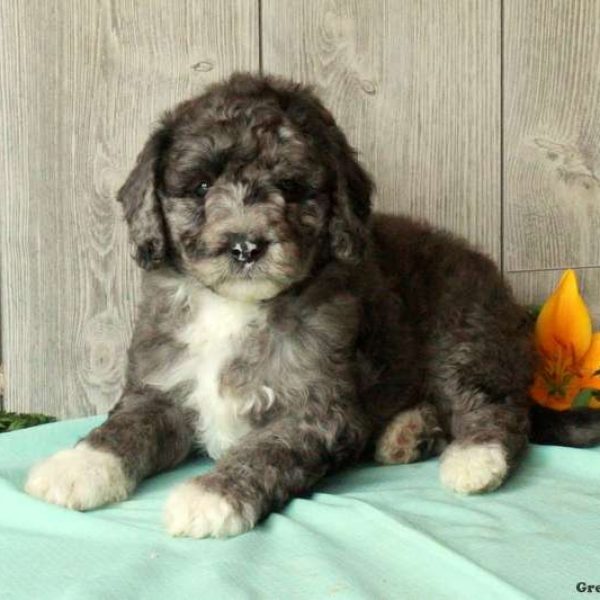
-
Activity Level:
high
-
Shedding Level:
moderate
-
Grooming Level:
moderate
-
Trainability:
high
-
Good for Novice Owners:
high
-
Adaptability:
high
-
Kid/Pet Friendly:
often
-
Prey Drive:
high
-
Watchdog:
aware
- Average Size: Medium
- Average Lifespan: 12-15 years
- Registered?: other
Borderdoodle Dog Breed Information
Overview
Temperament
Adaptability
Health
Owner Experience
Grooming
Activity Level
Size
Life Span
Did You Know?
The Borderdoodle, or Bordoodle, is a cross between a Border Collie and a Poodle. Although a mixed-breed dog can take on any combination of characteristics of one or both parent breeds, the Borderdoodle tends to be a friendly, affectionate, and loyal family dog.
Although they are not recognized by the American Kennel Club, they are recognized by other notable dog organizations. The Designer Dogs Kennel Club, International Designer Canine Registry, American Canine Hybrid Club, and more all recognize this dog breed, either as the Borderdoodle or the Bordoodle.
The Bordoodle is a playful, loving, and affectionate family dog. Well-socialized, they get along well with children, other pets, and other dogs. One of the facts about Border Collies is that they are quintessential herding dogs.
This means that Bordoodles can be prone to herding behavior, but don’t necessarily have a high prey drive. This is still something to consider with smaller pets in the household and may require some extra socialization and training to keep the herding behavior manageable and limited to appropriate activities.
They can be protective and initially wary of strangers, but tend to warm up once introduced, and do not tend to be aggressive as long as they have been properly socialized. As with any dog breed, poor socialization or training can result in poor behavior, including fear-based aggression. But, these dogs generally have a lively, social, and friendly disposition.
Although the Bordoodle tends to have a lot of energy, they can adapt well to just about any living situation. They will do well in large homes with room to roam as well as apartments, as long as they get enough exercise, mental stimulation, and attention every day.
They also do well in most climates. As with any dog, they are sensitive to heat and extreme cold. Because Bordoodles bond closely with their families, they thrive on attention and affection. This, paired with the fact that they are easily bored, means they do not like to be left alone for long periods of time.
If left to their own devices for too long, they can cause mischief and potentially become destructive. Destructive behavior is often a sign of boredom in dogs and can also be a sign that a dog isn’t getting enough exercise.
A mixed-breed dog can inherit the potential health concerns of one, both, or neither of the parent breeds. For the Bordoodle, potential health concerns to be aware of include allergies, epilepsy, hip dysplasia, and progressive retinal atrophy. Good breeding practices and the health of the parents make a big difference in the health of Bordoodle puppies.
Responsible breeders will screen their dogs to ensure preventable issues are not being passed on to puppies. So, don’t be afraid to ask the breeder about the genetic history of the parents and to see any relevant health clearances or results for health tests that have been done.
As a barrel-chested breed, a Bordoodle is also at a higher risk of bloat. Bloat in dogs can be dangerous, and quickly becomes fatal if gastric torsion occurs (i.e., if the stomach flips or twists). Knowing how to reduce the risk and what symptoms mean that it’s time to get to the emergency vet is important.
With both parent breeds being some of the smartest dog breeds, Bordoodles tend to be highly intelligent and highly trainable. Although they are eager to please and tend to pick up on things quickly, they are also easily bored. This can pose a challenge for some first-time dog owners.
But, overall, the Bordoodle tends to be highly trainable and a good fit for dog owners of all experience levels. They are eager to learn and respond best to positive methods focused on praise and rewards. Puppy training classes are always an option and are a great way to socialize a puppy, too.
Although one of the parent breeds in this mix is a Poodle, that doesn’t necessarily mean your Bordoodle will inherit the low-shedding Poodle coat or that they will be low-maintenance. When it comes to coat care, the Border Collie is lower maintenance than the Poodle, even though they shed more. You need to be prepared for either dog coat type or anything in between with your Bordoodle.
One of the facts about Poodles is that grooming is very important for their coat type. The Poodle coat may be low-shedding, but it requires daily brushing and almost monthly grooming in order to remove tangles, prevent mats, and stay healthy. The Border Collie coat sheds moderately year-round, with heavier shedding sessions twice a year as the seasons change. Brushing a Border Collie is on a weekly basis, and bathing is as needed.
In addition to coat care, you will also need to care for your Bordoodle’s nails, ears, and teeth. Cutting your dog’s nails on a once or twice monthly basis is usually sufficient to keep them from growing too long. Weekly ear checks with careful cleaning as needed can help prevent ear infections. Also, brushing your dog’s teeth or using an enzyme toothpaste every day, in addition to cleanings at the vet when needed, can help prevent painful dental diseases, like gum disease or tooth decay, later in life.
The Bordoodle can range from moderate to high energy, but they are usually high-energy dogs. Daily walks plus some playtime and time to run should be sufficient to keep this dog happy and healthy. But, they’ll probably be up for more activity if you are.
Trips to the dog park, playing frisbee, hiking, running, swimming with your dog, and more can all be great activities for you and your Bordoodle to do together. Just make sure to keep activities low-impact until Borderdoodle puppies finish growing to avoid damage to developing bones and joints.
Fully-grown Bordoodles usually stand 15-26 inches tall at the shoulder and weigh 20-80 pounds. Many Bordoodles tend to average 18-22 inches tall and 35-45 pounds. Although it’s not a guarantee, you can look at the size of the parents to get an idea of what size to expect in a particular Borderdoodle puppy once they are fully grown.
Borderdoodles generally live for 12-15 years on average.
The Bordoodle is also sometimes called a Borderdoodle, Border Collie Poodle, Borderpoo, Borpoo, or Border Poodle.






